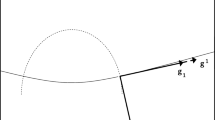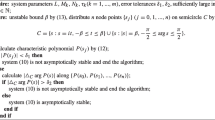Abstract
We develop a trigonometric scalar auxiliary variable (TSAV) approach for constructing linear, totally decoupled, and energy-stable numerical methods for gradient flows. An auxiliary variable r based on the trigonometric form of the nonlinear potential functional removes the bounded-from-below restriction. By adding a positive constant greater than 1, the positivity preserving property of r can be satisfied. Furthermore, the phase-field variables and auxiliary variable r can be treated in a totally decoupled manner, which simplifies the algorithm. A practical stabilization method is employed to suppress the effect of an explicit nonlinear term. Using our proposed approach, temporally first-order and second-order methods are easily constructed. We prove analytically the discrete energy dissipation laws of the first- and second-order schemes. Furthermore, we propose a multiple TSAV approach for complex systems with multiple components. A comparison of stabilized-SAV (S-SAV) and stabilized-TSAV (S-TSAV) approaches is performed to show their efficiency. Two-dimensional numerical experiments demonstrated the desired accuracy and energy stability.



















Similar content being viewed by others
References
Cahn JW, Hilliard JE (1958) Free energy of a nonuniform system. I. Interfacial free energy. J Chem Phys 28(2): 258–267
Ambati M, Gerasimov T, De Lorenzis L (2015) A review on phase-field models of brittle fracture and a new fast hybrid formulation. Comput Mech 55:383–405
Guo Z, Lin P (2015) A thermodynamically consistent phase-field model for two-phase flows with thermocapillary effects. J Fluid Mech 766:226–271
Marth W, Aland S, Voigt A (2016) Margination of white blood cells: a computational approach by a hydrodynamic phase field model. J Fluid Mech 790:389–406
Wheeler AA, Boettinger WJ, Mcfadden GB (1992) Phase-field model for isothermal phase transitions in binary alloys. Phys Rev A 45:7424–7439
Eyre DJ (1998) Unconditionally gradient stable time marching the Cahn–Hilliard equation. In: Bullard JW, Chen LQ (eds) Computational and mathematical models of microstructural evolution. MRS proceedings, Cambridge University Press, vol 529, pp 39–46
Shin J, Lee HG, Lee JY (2017) Convex splitting Runge-Kutta methods for phase-field models. Comput Math Appl 73:2388–2403
Shin J, Lee HG, Lee JY (2017) Unconditionally stable methods for gradient flow using Convex Splitting Runge-Kutta scheme. J Comput Phys 347:367–381
Liu Z, Li X (2019) Efficient modified techniques of invariant energy quadratization approach for gradient flows. Appl Math Lett 98:206–214
Yang J, Kim J (2021) An improved scalar auxiliary variable (SAV) approach for the phase-field surfactant model. Appl Math Model 90:11–29
Sun M, Feng X, Wang K (2020) Numerical simulation of binary fluid-surfactant phase field model coupled with geometric curvature on the curved surface. Comput Methods Appl Mech Eng 367(1):113123
Shen J, Xu J, Yang J (2018) The scalar auxiliary variable (SAV) approach for gradient flows. J Comput Phys 353:407–416
Hou D, Azaiez M, Xu C (2019) A variant of scalar auxiliary variable approaches for gradient flows. J Comput Phys 395:307–332
Huang F, Shen J, Yang Z (2020) A highly efficient and accurate new scalar auxiliary variable approach for gradient flows. SIAM J Sci Comput 42(4):A2514–A2536
Liu Z, Li X (2021) Step-by-step solving schemes based on scalar auxiliary variable and invariant energy quadratization approaches for gradient flows. Numer Algorithms (in press). https://doi.org/10.1007/s11075-021-01106-9
Liu Z, Li X (2020) The exponential scalar auxiliary variable (E-SAV) approach for phase field models and its explicit computing. SIAM J Sci Comput 42(3):B630–B655
Yan Y, Chen W, Wang C, Wise SM (2018) A second-order energy stable BDF numerical scheme for the Cahn-Hilliard equation. Commun Comput Phys 23:572–602
Wang S, Chen W, Pan H, Wang C (2020) Optimal rate convergence analysis of a second order scheme for a thin film model with slope selection. J Comput Appl Math 377:112855
Hao Y, Huang Q, Wang C (2020) A third order BDF energy stable linear scheme for the no-slope-selection thin film model (preprint). https://doi.org/10.4208/cicp.OA-2020-0074
Kim J (2012) Phase-field models for multi-component fluid flows. Commun Comput Phys 12(3):613–661
Shen J, Xu J (2018) Convergence and error analysis for the scalar auxiliary variable (SAV) schemes to gradient flows. SIAM J Numer Anal 56(5):2895–2912
Yoon S, Jeong D, Lee C, Kim H, Kim S, Lee HG, Kim J (2020) Fourier-spectral method for the phase-field equations. Mathematics 8(8):1385
Feng X, Tang T, Yang J (2013) Stabilized Crank-Nicolson/Adams-Bashforth schemes for phase field models. East Asian J Appl Math 3(1):59–80
Luo F, Tang T, Xie H (2016) Parameter-Free time adaptivity based on energy evolution for the Cahn-Hilliard equation. Commun Comput Phys 19(5):1542–1563
Cheng K, Feng W, Wang C, Wise SM (2019) An energy stable fourth order finite difference scheme for the Cahn-Hilliard equation. J Comput Appl Math 362:574–595
Feng W, Guan Z, Lowengrub J, Wang C, Wise SM, Chen Y (2018) A uniquely solvable, energy stable numerical scheme for the functionalized Cahn-Hilliard equation and its convergence analysis. J Sci Comput 76(3):1938–1967
Guo J, Wang C, Wise SM, Yue X (2016) An \(H^2\) convergence of a second-order convex-splitting, finite difference scheme for the three-dimeniosnal Cahn-Hilliard equation. Commun Math Sci 14(2):489–515
Diegel AE, Wang C, Wise SM (2016) Stability and convergence of a second-order mixed finite element method for the Cahn-Hilliard equation. IMA J Numer Anal 36(4):1867–1897
Cheng K, Wang C, Wise SM, Yue X (2016) A second-order, weakly energy-stabe pseudo-spectral scheme for the Cahn-Hilliard equation and its solution by the homogeneous linear iteration method. J Sci Comput 69(3):1083–1114
Guo J, Wang C, Wise SM, Yue X (2021) An improved error analysis for a second-order numerical scheme for the Cahn–Hilliard equation. J Comput Appl Math 388:113300
Elder K, Katakowski M, Haataja M, Grant M (2002) Modeling elasticity in crystal growth. Phys Rev Lett 88:245701
Cheng K, Wang C, Wise SM (2019) An energy stable BDF2 Fourier Pseudo-Spectral numerical scheme for the square phase field crystal equation (preprint). https://doi.org/10.4208/cicp.2019.js60.10
Xia B, Mei C, Yu Q, Li Y (2020) A second order unconditionally stable scheme for the modified phase field crystal model with elastic interaction and stochastic noise effect. Comput Methods Appl Mech Eng 363:112795
Li Y, Luo C, Xia B, Kim J (2019) An efficient linear second order unconditionally stable direct discretization method for the phase-field crystal equation on surfaces. Appl Math Model 67:477–490
Shin J, Lee HG, Lee JY (2020) Long-time simulation of the phase-field crystal equation using high-order energy stable CSRK methods. Comput Methods Appl Mech Eng 364:112981
Lee HG, Shin J, Lee JY (2017) First- and second-order energy stable methods for the modified phase field crystal equation. Comput Methods Appl Mech Eng 321(1):1–17
Wise SM, Wang C, Lowengrub JS (2009) An energy-stable and convergent finite-difference scheme for the phase field crystal equation. SIAM J Numer Anal 47(3):2269–2288
Wang C, Wise SM (2011) An energy stable and convergent finite-difference scheme for the modified phase field crystal equation. SIAM J Numer Anal 49(3):945–969
Baskaran A, Lowengrub JS, Wang C, Wise SM (2013) Convergence analysis of a second order convex splitting scheme for the modified phase field crystal equation. SIAM J Numer Anal 51(5):2851–2873
Dong L, Feng W, Wang C, Wise SM, Zhang Z (2018) Convergence analysis and numerical implementation of a second order numerical scheme for the three-dimensional phase field crystal equation. Comput Math Appl 75(6):1912–1928
Lee HG (2019) An energy stable method for the Swift-Hohenberg equation with quadratic-cubic nonlinearity. Comput Methods Appl Mech Eng 343(1):40–51
Swift J, Hohenberg PC (1977) Hydrodynamic fluctuation at the convective instability. Phys Rev A 15:319–328
Cross MC, Hohenberg PC (1993) Pattern formation outside of equilibrium. Rev Mod Phys 65:851–1112
Kim J (2009) A generalized continuous surface tension force formulation for phase-field models for multi-component immiscible fluid flows. Comput Methods Appl Mech Eng 198:3105–3112
Li HL, Liu HR, Ding H (2020) A fully 3D simulation of fluid-structure interaction with dynamic wetting and contact angle hysteresis. J Comput Phys 420(1):109709
Zhang JT, Liu HR, Ding H (2020) Head-on collision of two immiscible droplets of different components. Phys Fluids 32:082106
Aihara S, Takaki T, Takada N (2019) Multi-phase-field modeling using a conservative Allen-Cahn equation for multiphase flow. Comput Fluids 178(15):141–151
Yang J, Kim J (2020) An unconditionally stable second-order accurate method for systems of Cahn–Hilliard equations. Commun Nonlinear Sci Numer Simul 87:105276
Yang J, Li Y, Lee C, Jeong D, Kim J (2019) A conservative finite difference scheme for the \(N\)-component Cahn-Hilliard system on curved surfaces in 3D. J Eng Math 119:149–166
Li XL, Shen J, Liu ZG (2021) New SAV-pressure correction methods for the Navier–Stokes equations: stability and error analysis
Yang J, Kim J (2021) A variant of stabilized-scalar auxiliary variable (S-SAV) approach for a modified phase-field surfactant model. Comput Phys Commun 261:107825
Chiu PH (2019) A coupled phase field framework for solving incompressible two-phase flows. J Comput Phys 392(1):115–140
Guo Z, Lin P, Lowengrub J, Wise SM (2017) Mass conservative and energy stable finite difference methods for the quasi-incompressible Navier-Stokes-Cahn-Hilliard system: primitive variable and projection-type schemes. Comput Methods Appl Mech Eng 326:144–174
Acknowledgements
J. Yang was supported by China Scholarship Council (201908260060). The corresponding author (J.S. Kim) was supported by Basic Science Research Program through the National Research Foundation of Korea(NRF) funded by the Ministry of Education(NRF-2019R1A2C1003053). The authors are grateful to the reviewers for their contributions to improve this paper.
Author information
Authors and Affiliations
Corresponding author
Additional information
Publisher's Note
Springer Nature remains neutral with regard to jurisdictional claims in published maps and institutional affiliations.
Rights and permissions
About this article
Cite this article
Yang, J., Kim, J. The stabilized-trigonometric scalar auxiliary variable approach for gradient flows and its efficient schemes. J Eng Math 129, 18 (2021). https://doi.org/10.1007/s10665-021-10155-x
Received:
Accepted:
Published:
DOI: https://doi.org/10.1007/s10665-021-10155-x




